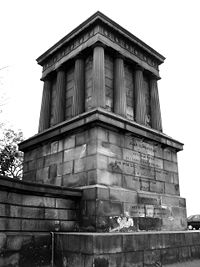
Playfair's axiom
Encyclopedia

Axiom
In traditional logic, an axiom or postulate is a proposition that is not proven or demonstrated but considered either to be self-evident or to define and delimit the realm of analysis. In other words, an axiom is a logical statement that is assumed to be true...
, intended to replace the fifth postulate of Euclides (the Parallel postulate
Parallel postulate
In geometry, the parallel postulate, also called Euclid's fifth postulate because it is the fifth postulate in Euclid's Elements, is a distinctive axiom in Euclidean geometry...
):
Given a line and a point not on it, at most one parallelParallel (geometry)Parallelism is a term in geometry and in everyday life that refers to a property in Euclidean space of two or more lines or planes, or a combination of these. The assumed existence and properties of parallel lines are the basis of Euclid's parallel postulate. Two lines in a plane that do not...
to the given line can be drawn through the point.
It is equivalent to Euclid's parallel postulate
Parallel postulate
In geometry, the parallel postulate, also called Euclid's fifth postulate because it is the fifth postulate in Euclid's Elements, is a distinctive axiom in Euclidean geometry...
and was named after the Scottish mathematician
Mathematician
A mathematician is a person whose primary area of study is the field of mathematics. Mathematicians are concerned with quantity, structure, space, and change....
John Playfair
John Playfair
John Playfair FRSE, FRS was a Scottish scientist and mathematician, and a professor of natural philosophy at the University of Edinburgh. He is perhaps best known for his book Illustrations of the Huttonian Theory of the Earth , which summarized the work of James Hutton...
. It is only required to state "at most" because the rest of the postulates will imply that there is exactly one. It could perfectly be assumed to write it saying "there is one and only one parallel".
It is important to remark that in the Euclid book, two lines are said to be parallel if they never meet. It does not matter if their distance is always the same or not.
When David Hilbert
David Hilbert
David Hilbert was a German mathematician. He is recognized as one of the most influential and universal mathematicians of the 19th and early 20th centuries. Hilbert discovered and developed a broad range of fundamental ideas in many areas, including invariant theory and the axiomatization of...
made his Hilbert's axioms
Hilbert's axioms
Hilbert's axioms are a set of 20 assumptions proposed by David Hilbert in 1899 in his book Grundlagen der Geometrie , as the foundation for a modern treatment of Euclidean geometry...
he used Playfair's axiom instead of the original one from Euclid.
History
In 1795 Playfair published an alternative, more stringent formulation of Euclid's parallel postulate, which is now called Playfair's axiom; though the axiom bears Playfair's name, he did not create it, but credited others, in particular William Ludlam (1718–1788), with the prior use of it.Relation with Euclid's fifth postulate

If a line segmentLine segmentIn geometry, a line segment is a part of a line that is bounded by two end points, and contains every point on the line between its end points. Examples of line segments include the sides of a triangle or square. More generally, when the end points are both vertices of a polygon, the line segment...
intersects two straight linesLine (mathematics)The notion of line or straight line was introduced by the ancient mathematicians to represent straight objects with negligible width and depth. Lines are an idealization of such objects...
forming two interior angles on the same side that sum to less than two right angleRight angleIn geometry and trigonometry, a right angle is an angle that bisects the angle formed by two halves of a straight line. More precisely, if a ray is placed so that its endpoint is on a line and the adjacent angles are equal, then they are right angles...
s, then the two lines, if extended indefinitely, meet on that side on which the angles sum to less than two right angles.
holds because two lines on a sphere always meet. Playfair's postulate is therefore stronger and prevents elliptic geometries. Therefore, it is not possible to derive Playfair's postulate from Euclid Fifth alone.

